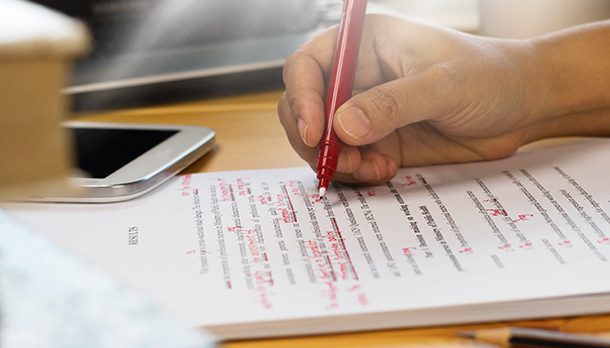The art of essay writing

Before artists begin to paint, they may coat their canvas with an earth-tone wash, and outline the basic shapes with raw umber, yellow ochre, and titanium white. This first step, known as the “under-painting”, leaves the artist with an outline of no intrinsic artistic value. However, this step does allow them to overcome the intimidatingly white canvas and better see the directions that their strokes should take. A similar approach should be taken when approaching an essay. Whether staring at a blank canvas or a blank document, the taunting white of the blank slate can be a primary contributor to stress, leading to mental blocks and procrastination. To reduce stress and increase productivity, I propose taking the following measures regarding the preparation, writing, and editing of an essay.
Preparation
Before you sit down to write, make sure to clean your desk and yourself. Writing in a clean and clear space will help to reduce distractions and anxiety. Furthermore, do not try to write in your pajamas. Dress comfortably, but as if you plan to leave the house. Your writing should be academic, and wearing clothing closely associated with sleep is not ideal for entering an academic mindset.
Writing a university essay involves a lot of careful thinking
Once you have cleared your space, devise a “game plan.” This will involve establishing a daily word quota. Set a goal that is high, but not overwhelming. That way, even your failure can be your success. For instance, if you need to write 500 words a day, aim for 1,000. If you succeed, you can feel the rare relief of being ahead of schedule. Even if you only manage to write around 500 words, you may relax knowing you can complete your task on time. With this completed, it is time to start “sketching out” your ideas.
If you are uninspired or indecisive about what to write about, do not worry. Remember that as you write, your thesis statement or research question will likely evolve. Remaining open to finding faults in your argument, and allowing your thoughts to develop as you work, will yield a more well-rounded argument. With the stress of devising an ingenious thesis statement out of the way, begin by composing a list of important points of interest. A “stream-of-consciousness” approach works well here.
Once you have some ideas down, and the blank page no longer taunts you with its infinite possibility, you may consider which of the ideas you have written strikes you as the most interesting. Which do you know the most about, or have the most to say about? Then, try to formulate a working thesis statement or question based on those ideas. Next, write no more than three main points or questions branching from your thesis. Keep these as simple as possible. The simpler the topic, the more thorough the essay may be and the less likely you will be overwhelmed. Once you have simplified your outline, it is time to write.
Writing
If you are not someone who can write a nearly-perfect first draft, know there is no harm in spilling your chaotic thought processes onto the page. Like the artist, you need to first wash that canvas with earth tones before you can carve away the lights and shadows. This is your time to conquer the white page with words to later organize, cut and elaborate on.
In this time, it is useful to take breaks at regular intervals. Stretch, go for a walk or get some form of exercise to keep your mind fresh. Taking regular breaks will keep your energy level up, your stress level down, and give you time to process your thoughts. It may also help to change your work setting. Try writing in different locations: a café, the library, the park, or even a different area of your flat. The last way you should feel when writing an essay is trapped.
Editing
Printing your essay out will allow you to break away from the sickening backlight of your computer and engage in a more tactile editing process. Best of all, without the temptation of wifi, there will be far fewer distractions for you. Take the papers to the park, the library, your favorite café, or anywhere else that allows you to relax and focus on your task.
Like a day of spring cleaning, find pleasure in purging your essay of all unnecessary words. Watch as your ideas spring forth from the muck. See yourself as a sculptor bringing to life the statue buried within the marble, or as a painter refining his sketchy brushstrokes.
My professor once told me, “Sometimes you must kill your favorite child.” A play on Arthur Quiller-Couch’s “Murder your darlings,” her particular phrasing has stuck with me. Whether writing creatively or academically, you are the creator of those clever little sentences and paragraphs that you feel show off your true level of intellect. However, there may come a time when you must cut them from your text, but you need not “kill” them. Save those precious excerpts in a separate document. They may prove fruitful later.
Once you have completed editing the rough draft, it is time to write a more organized essay. Change the original structure if necessary, and do not worry about perfecting the introduction for now, as it will change as your argument develops. Cut the convoluted, elaborate underdeveloped ideas, tie your thoughts together with fluid transitions, and conclude. The paper does not need to be perfect, for now, and with your newly refined skeleton, you may approach your task with confidence. Repeat the writing and editing processes for a second and, if time permits, third draft. When you feel your essay is complete, go back to the introduction to make all the proper adjustments. Take a step back, and admire your masterpiece.
Related Articles
UNYP Chronicle Newsletter
The e-mail address you provide will be used only to send you the newsletter. Your privacy is important to us.
For more information download our UNYP Brochure.

Contacts
University of New York in Prague
Londýnská 41, 120 00 Praha
ID no: 25676598
Phone:
+420 224 221 261
![]() Skype
Skype
Email: unyp@unyp.cz








